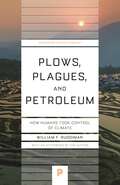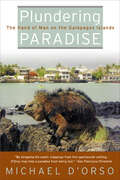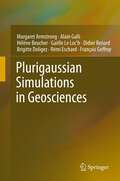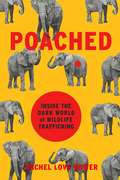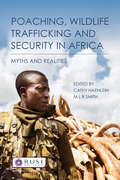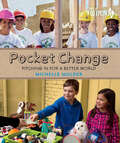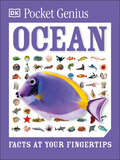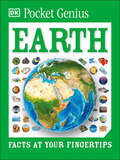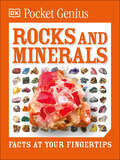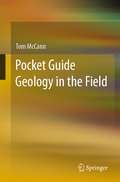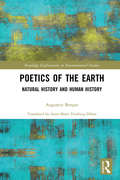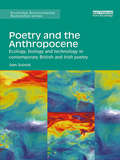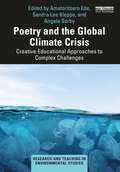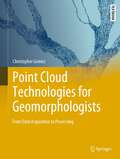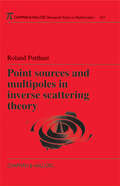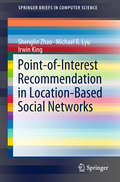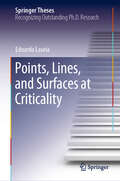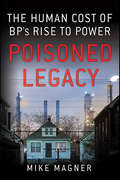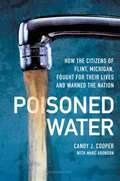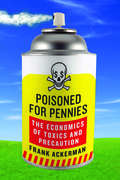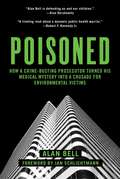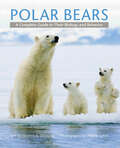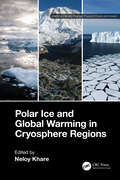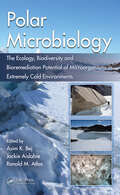- Table View
- List View
Plows, Plagues, and Petroleum: How Humans Took Control of Climate (Princeton Science Library #46)
by William F. RuddimanThe impact on climate from 200 years of industrial development is an everyday fact of life, but did humankind's active involvement in climate change really begin with the industrial revolution, as commonly believed? Plows, Plagues, and Petroleum has sparked lively scientific debate since it was first published--arguing that humans have actually been changing the climate for some 8,000 years--as a result of the earlier discovery of agriculture.The "Ruddiman Hypothesis" will spark intense debate. We learn that the impact of farming on greenhouse-gas levels, thousands of years before the industrial revolution, kept our planet notably warmer than if natural climate cycles had prevailed--quite possibly forestalling a new ice age.Plows, Plagues, and Petroleum is the first book to trace the full historical sweep of human interaction with Earth's climate. Ruddiman takes us through three broad stages of human history: when nature was in control; when humans began to take control, discovering agriculture and affecting climate through carbon dioxide and methane emissions; and, finally, the more recent human impact on climate change. Along the way he raises the fascinating possibility that plagues, by depleting human populations, also affected reforestation and thus climate--as suggested by dips in greenhouse gases when major pandemics have occurred. While our massive usage of fossil fuels has certainly contributed to modern climate change, Ruddiman shows that industrial growth is only part of the picture. The book concludes by looking to the future and critiquing the impact of special interest money on the global warming debate. In the afterword, Ruddiman explores the main challenges posed to his hypothesis, and shows how recent investigations and findings ultimately strengthen the book's original claims.
Plundering Paradise: The Hand of Man on the Galápagos Islands
by Michael D'OrsoMention the Galápagos Islands to almost anyone, and the first things that spring to mind are iguanas, tortoises, volcanic beaches, and, of course, Charles Darwin. But there are people living there, too -- nearly 20,000 of them. A wild stew of nomads and grifters, dreamers and hermits, wealthy tour operators and desperately poor South American refugees, these inhabitants have brought crime, crowding, poaching, and pollution to the once-idyllic islands. In Plundering Paradise, Michael D'Orso explores the conflicts on land and at sea that now threaten to destroy this fabled "Eden of Evolution."
Plurigaussian Simulations in Geosciences
by Margaret Armstrong Brigitte Doligez Francois Geffroy Hélène Beucher Rémi Eschard Didier Renard Gaelle Loc'H Alain GalliSimulation is the fastest developing branch of geostatistics and simulating facies inside reservoirs and orebodies is the most exciting part of this. Several methods have been developed to do this (sequential indicator simulations, Boolean simulations, Markov chains and plurigaussian simulations). This book focuses on the last type of simulations. It presents the theory required to understand the method, along practical examples of applications in mining and the oil industry as well as tutorial exercises. Demonstration software to illustrate how these simulations work is available on http://pluridemo.geosciences.mines-paristech.fr Since the publication of the first edition, enormous numbers of papers have appeared in the literature on the subject. Plurigaussian simulations are now the preferred method for simulating facies in both mining & the oil industry. The new edition contains new case studies in both mining & petroleum, together with an extensively updated theory section.
Poached: Inside the Dark World of Wildlife Trafficking (A Merloyd Lawrence Book)
by Rachel Love NuwerAn intrepid investigation of the criminal world of wildlife trafficking--the poachers, the traders, and the customers--and of those fighting against itJournalist Rachel Nuwer plunges the reader into the underground of global wildlife trafficking, a topic she has been investigating for nearly a decade. Our insatiable demand for animals--for jewelry, pets, medicine, meat, trophies, and fur--is driving a worldwide poaching epidemic, threatening the continued existence of countless species. Illegal wildlife trade now ranks among the largest contraband industries in the world, yet compared to drug, arms, or human trafficking, the wildlife crisis has received scant attention and support, leaving it up to passionate individuals fighting on the ground to try to ensure that elephants, tigers, rhinos, and more are still around for future generations.As Reefer Madness (Schlosser) took us into the drug market, or Susan Orlean descended into the swampy obsessions of The Orchid Thief, Nuwer--an award-winning science journalist with a background in ecology--takes readers on a narrative journey to the front lines of the trade: to killing fields in Africa, traditional medicine black markets in China, and wild meat restaurants in Vietnam. Through exhaustive first-hand reporting that took her to ten countries, Nuwer explores the forces currently driving demand for animals and their parts; the toll that demand is extracting on species across the planet; and the conservationists, rangers, and activists who believe it is not too late to stop the impending extinctions. More than a depressing list of statistics, Poached is the story of the people who believe this is a battle that can be won, that our animals are not beyond salvation.
Poaching, Wildlife Trafficking and Security in Africa: Myths and Realities (Whitehall Papers)
by Cathy Haenlein M L SmithA worldwide surge in poaching and wildlife trafficking is threatening to decimate endangered species. This crisis also threatens the security of human beings in ways ignored until recently by decision-makers slow to begin to treat what is typically viewed as a ‘conservation issue’ as serious crime. Over the past decade, as the scale and profitability of poaching and wildlife trafficking have grown, politicians, journalists and campaigners throughout the world have begun to take notice – they are offering striking appraisals of the threat posed not only to endangered species but also to human populations. Many of these appraisals, however, are made in the absence of a detailed body of empirical research and analysis to underpin them. The result is the growth of a range of myths and misperceptions around the security threats posed, particularly as they relate to Africa. Poaching, Wildlife Trafficking and Security in Africa examines the most common narratives on poaching, wildlife trafficking and security. It critically analyses the dominant discourses on poaching and wildlife trafficking as threats to human security, as drivers of conflict, as funders of terrorism and as a focus for organised crime. In doing so, it seeks to sort myth from reality, to clarify how poaching and wildlife trafficking, as much cited threats to security, can most accurately be conceived. Such a study is crucial to the efforts of stakeholders now rightly looking to respond not just to the threat posed to endangered species, but also to the security and wellbeing of human beings.
Pocket Change: Pitching In for a Better World (Orca Footprints #9)
by Michelle MulderUntil a few hundred years ago, people were embarrassed to buy bread in a store. Families took pride in making almost everything they owned. These days, many people take pride in buying as much as possible! New clothes, a speedier bicycle, the latest phone. If we've got money, someone can sell us a product that will supposedly make our lives better. But each year, humanity uses resources equivalent to nearly one and a half Earths, and we're still not meeting everyone's needs. Around the world, people are questioning consumerism, leaning toward more sustainable lifestyles and creating a whole new concept of wealth. What if you could meet all your needs while getting to know your neighbors and protecting the environment at the same time? Find out how growing a tiny cabbage can fight poverty, how a few dollars can help ten families start their own businesses and how running errands for a neighbor can help you learn to become a bike mechanic--for free!
Pocket Genius Ocean (Pocket Genius)
by DKExplore all the wonders of the ocean in one pocket-sized reference guide!From colossal whales to microscopic plankton, our vast oceans are teeming with a wide range of weird and wonderful plants and animals. This beautifully illustrated reference guide is perfect for budding explorers aged 9-12, teaching and helping them discover the secrets of the underwater kingdom! In this go-to reference guide, you&’ll find: • A clear, informative introduction to oceans – what they are, what creatures they hold, how they affect climate, and how humans are changing them • Divided into chapters based on habitats, from the coastline to the ocean floor • Presents information in bite-sized chunks for both avid and reluctant readers, supported by artworks that explain difficult concepts in a simple way With nearly 97% of the planet&’s water held in the oceans, there is an incredible variety of creatures that call the ocean home. This mini-encyclopedia explores all the different marine habitats from tidal pools and salt marshes to coral reefs and ocean floor ridges, to name a few. Curious kids interested in the seven seas will also learn about how oceans are formed, what causes tsunamis and typhoons and how tidal waves are used to generate electricity. This beautifully illustrated reference guide is also the perfect introduction to ocean conservation. Young readers can explore the ways marine experts are working to ensure the survival of our oceans in the wake of global warming. Amazing photography paired with simple information makes Pocket Eyewitness Ocean perfect for all budding explorers!
Pocket Genius: Facts at Your Fingertips (Pocket Genius)
by DKThe prefect sized books for backpacks, DK's Pocket Genius series is bright, inviting, concise, and punchy — the ideal source for reference. Featuring essential information, full-color images, glossary, and top ten lists, these books are a brand-new type of encyclopedia for young readers. A visual look at the planet we call home, Pocket Genius Earth delves into Earth's geology and geography, examining oceans, mountains, deserts, clouds, and more. Supports the Common Core State Standards.
Pocket Genius: Facts at Your Fingertips (Pocket Genius)
by DKDestined to be toted in school backpacks everywhere, this new encyclopedia series for young readers contains on-the-spot information in children's favorite subject areas. Kids love facts: they want to know about the biggest, fastest, tallest, and oldest everything. Full of instant information, these books feature a fresh design that is sure to appeal to the middle grade audience. These single-subject guides offer a unique catalog-style presentation, which clearly lays out individual subcategories with concise and punchy text covering all of the essential information on whatever topic is at-hand. Pocket Genius: Rocks and Minerals profiles nearly 200 types of rocks and minerals from volcanic rocks and granite to sparkling diamonds and explosive sulfur, and tells what they are made of, how they are formed and what they are used for. Supports the Common Core State Standards.
Pocket Guide Geology in the Field
by Tom McCannThis book is a field guide that describes and explains the commonest minerals and rocks as well as introducing the most important fossil groups. In addition, a variety of geological structures are described and illustrated in the numerous diagrams and photographs. The guide is your perfect companion for hikes or walks in the countryside, inviting you to discover the geology hidden behind the landscapes surrounding us, as well as helping you to recognise the various minerals, rocks and fossils, you might encounter. Geology is a science that only really comes to life when we are outside, for example, on walks or hikes along the coast or through national parks. With a little knowledge you will be able to experience the landscape in a completely different way. The rocks will “come alive”, so to speak, and you will be able to read their history like a book - understanding the range and complexity of geological processes which have formed the Earth beneath our feet. Such processes - an interplay of magmatism, tectonics, metamorphosis and sedimentation, as well as climate and sea-level change - have shaped the Earth over millennia and continue to do so even at the present time. The book is aimed at nature lovers of all types, as well as students of geology – in fact, anyone who is interested in the world around us. It will provide the perfect companion for walks or hikes in the countryside. This book is a translation of the original German 1st edition Pocket Guide Geologie im Gelände by Tom McCann, published by Springer-Verlag GmbH Germany, part of Springer Nature in 2019. The initial translation was done with the help of artificial intelligence (machine translation by the service DeepL.com). A subsequent detailed revision by the author ensures that the book reads stylistically like a conventional translation. Springer Nature works continuously to further the development of tools for the production of books and on the related technologies to support the authors.
Poetics of the Earth: Natural History and Human History (Routledge Explorations in Environmental Studies)
by Augustin BerquePoetics of the Earth is a work of environmental philosophy, based on a synthesis of eastern and western thought on natural and human history. It draws on recent biological research to show how the processes of evolution and history both function according to the same principles. Augustin Berque rejects the separation of nature and culture which he believes lies at the root of the environmental crisis. This book proposes a three stage process of "re-worlding" (moving away from the individualized self to become a part of the common world), "re-concretizing" (understanding the meaning and historical development of words and things) and "re-engaging" (reconsidering the relationship between history and subjectivity at every level of being) in order to bring western thought on nature and culture into sustainable harmony and alignment. This book will be of great interest to students and scholars of environmental studies, environmental philosophy, Asian studies and the natural sciences.
Poetry and the Anthropocene: Ecology, biology and technology in contemporary British and Irish poetry (Routledge Environmental Humanities)
by Sam SolnickThis book asks what it means to write poetry in and about the Anthropocene, the name given to a geological epoch where humans have a global ecological impact. Combining critical approaches such as ecocriticism and posthumanism with close reading and archival research, it argues that the Anthropocene requires poetry and the humanities to find new ways of thinking about unfamiliar spatial and temporal scales, about how we approach the metaphors and discourses of the sciences, and about the role of those processes and materials that confound humans’ attempts to control or even conceptualise them. Poetry and the Anthropocene draws on the work of a series of poets from across the political and poetic spectrum, analysing how understandings of technology shape literature about place, evolution and the tradition of writing about what still gets called Nature. The book explores how writers’ understanding of sciences such as climatology or biochemistry might shape their poetry’s form, and how literature can respond to environmental crises without descending into agitprop, self-righteousness or apocalyptic cynicism. In the face of the Anthropocene’s radical challenges to ethics, aesthetics and politics, the book shows how poetry offers significant ways of interrogating and rendering the complex relationships between organisms and their environments in a world increasingly marked by technology.
Poetry and the Global Climate Crisis: Creative Educational Approaches to Complex Challenges (Research and Teaching in Environmental Studies)
by Angela Sorby Amatoritsero Ede Sandra Lee KleppeThis book demonstrates how humans can become sensitized to, and intervene in, environmental degradation by writing, reading, analyzing, and teaching poetry. It offers both theoretical and practice-based essays, providing a diversity of approaches and voices that will be useful in the classroom and beyond. The chapters in this edited collection explore how poetry can make readers climate-ready and climate-responsive through creativity, empathy, and empowerment. The book encompasses work from or about Oceania, Africa, Europe, North America, Asia, and Antarctica, integrating poetry into discussions of specific local and global issues, including the value of Indigenous responses to climate change; the dynamics of climate migration; the shifting boundaries between the human and more-than-human world; the ecopoetics of the prison-industrial complex; and the ongoing environmental effects of colonialism, racism, and sexism. With numerous examples of how poetry reading, teaching, and learning can enhance or modify mindsets, the book focuses on offering creative, practical approaches and tools that educators can implement into their teaching and equipping them with the theoretical knowledge to support these. This volume will appeal to educational professionals engaged in teaching environmental, sustainability, and development topics, particularly from a humanities-led perspective.
Point Cloud Technologies for Geomorphologists: From Data Acquisition to Processing (Springer Textbooks in Earth Sciences, Geography and Environment)
by Christopher GomezStarting from concrete examples in Geomorphology, this comprehensive textbook explains to graduate and postgraduate students, point-cloud data technology and associated methods from acquisition to final-product generation. In the last few decades, Geo-sciences have experienced a paradigm shift from the challenge of collecting enough data to the need of creating new processing tools that can handle the billions of data. This shift has come to Geomorphology with the increasing use of surface-pointclouds obtained from photogrammetry, laser scanners and processed by specialist software, and it is thus necessary for the next generation of geomorphologist to be fluent in these technologies. Consequently, this book explains from concrete examples how to use pointcloud technologies, from data collection to processing and final product generation. The philosophy of this book relies on two principles, first: you do not have to be a tech-wizard to use pointcloud technologies, allowing the you to bring back the focus on your science; second pointcloud methods can be affordable, therefore the book provide a set of worked-examples in the different geomorphological environments using open source software and R and Python code samples. The book can be used as a textbook in a geomorphology, geology, physical geography, Sabo-sciences and engineering class, as well as a companion for the more seasoned scientist who wants to solve specific problems.
Point Sources and Multipoles in Inverse Scattering Theory (Chapman & Hall/CRC Research Notes in Mathematics Series)
by Roland PotthastOver the last twenty years, the growing availability of computing power has had an enormous impact on the classical fields of direct and inverse scattering. The study of inverse scattering, in particular, has developed rapidly with the ability to perform computational simulations of scattering processes and led to remarkable advances in a range of
Point-of-Interest Recommendation in Location-Based Social Networks (SpringerBriefs in Computer Science)
by Irwin King Michael R. Lyu Shenglin ZhaoThis book systematically introduces Point-of-interest (POI) recommendations in Location-based Social Networks (LBSNs). Starting with a review of the advances in this area, the book then analyzes user mobility in LBSNs from geographical and temporal perspectives. Further, it demonstrates how to build a state-of-the-art POI recommendation system by incorporating the user behavior analysis. Lastly, the book discusses future research directions in this area. This book is intended for professionals involved in POI recommendation and graduate students working on problems related to location-based services. It is assumed that readers have a basic knowledge of mathematics, as well as some background in recommendation systems.
Points, Lines, and Surfaces at Criticality (Springer Theses)
by Edoardo LauriaThis thesis offers a fascinating journey through various non-perturbative aspects of Conformal Theories, in particular focusing on the Conformal Bootstrap Programme and its extensions to theories with various degrees of symmetry. Because of the preeminent role of Conformal Theories in Nature, as well as the great generality of the results here obtained, this analysis directly applies to many different areas of research. The content of this thesis is certainly relevant for the physics community as a whole and this relevance is well motivated and discussed along the various chapters of this work.The work is self-contained and starts with an original introduction to conformal theories, defects in such theories and how they lead to constraints on data and an extension of the bootstrap programme. This situation is often realized by critical systems with impurities, topological insulators, or – in the high-energy context – by Wilson and 't Hooft operators. The thesis continues with original research results of the author, including supersymmetric extensions. These results may be relevant non only in the high energy physics context - where supersymmetry is required for the theory to be consistent - but also for condensed matter systems that enjoy supersymmetry emergence at long distances.
Poisoned Legacy: The Human Cost of BP's Rise to Power
by Mike MagnerThe story is all too-familiar: On April 20, 2010, the Deepwater Horizon oil rig exploded, killing eleven workers and creating the largest oil spill in the history of U.S. offshore drilling. But, this wasn't the first time British Petroleum and its cost-cutting practices destroyed parts of the natural world. It also was not the first time that BP's negligence resulted in the loss of human life, ruined family businesses or shattered dreams. Journalist Mike Magner has been tracking BP's reckless path for years and, for the first time, focuses on the human price of BP's rise to power. From Alaska to Kansas to the Gulf, Magner has talked to people whose lives have been destroyed by BP's almost unparalleled corporate greed. When BP acquired an abandoned Kansas refinery in 1998, it discovered one of the most contaminated groundwater plumes in the U.S. Rather than begin a full cleanup, BP declared there was no cause for concern. A former schoolteacher alarmed by cancer cases in the town pushed her community to take BP to court. In 2005, an explosion at BP's Texas City refinery, operating with a raft of safety problems because of neglected maintenance, killed fifteen people including the mother and father of a young woman who was driving there to spend the Easter holidays with her parents. A year later, thousands of gallons of oil spilled onto Alaska's North Slope from a corroded BP pipeline. Following a hurricane, BP's Thunder Horse rig almost sank because of a flaw in its construction, and repair work exposed even more serious problems. Poisoned Legacy is the searing true story of the rise and fall of BP, a company that went from being a green maverick promising a world "Beyond Petroleum" to one of the most notorious corporate villains in history.
Poisoned Water: How the Citizens of Flint, Michigan, Fought for their Lives and warned the Nation
by Candy J. CooperBased on original reporting by a Pulitzer Prize finalist and an industry veteran, the first book for young adults about the Flint water crisis. In 2014, Flint, Michigan, was a cash-strapped city that had been built up, then abandoned by General Motors. As part of a plan to save money, government officials decided that Flint would temporarily switch its water supply from Lake Huron to the Flint River. Within months, many residents broke out in rashes. Then it got worse: children stopped growing. Some people were hospitalized with mysterious illnesses; others died. Citizens of Flint protested that the water was dangerous. Despite what seemed so apparent from the murky, foul-smelling liquid pouring from the city’s faucets, officials refused to listen. They treated the people of Flint as the problem, not the water, which was actually poisoning thousands. Through interviews with residents and intensive research into legal records and news accounts, journalist Candy J. Cooper, assisted by writer-editor Marc Aronson, reveals the true story of Flint. The book shows not just how the crisis unfolded in 2014, but also the history of racism and segregation that led up to it, the beliefs and attitudes that fueled it, and how the people of Flint fought―and are still fighting―for clean water and healthy lives.
Poisoned for Pennies: The Economics of Toxics and Precaution
by Frank Ackerman"Cost-benefit analysis" is a term that is used so frequently we rarely stop to think about it. But relying on it can lead to some dubious conclusions, as Frank Ackerman points out in this eye-opening book. For example, some economists have argued that states should encourage--and even subsidize--cigarette smoking by citizens because smoking will shorten life spans and therefore reduce the need and expense of caring for the elderly. How did the economists reach that conclusion? The answer is cost-benefit analysis, Ackerman explains. Then in clear, understandable language, he describes an alternative, precautionary approach to making decisions under uncertainty. Once a mere theory, the precautionary principle has now been applied in practice through the European Union's REACH protocol. Citing major studies, many of which he has directed, he shows that the precautionary approach has not only worked, but has been relatively cheap. Poisoned for Pennies shows how the misuse of cost-benefit analysis is impeding efforts to clean up and protect our environment, especially in the case of toxic chemicals. According to Ackerman, conservatives--in elected office, in state and federal regulatory agencies, and in businesses of every size--have been able to successfully argue that environmental clean-up and protection are simply too expensive. But he proves, that is untrue in case after case. Ackerman is already well known for his carefully reasoned attacks on the conventional wisdom about the costs of environmental regulation. This new book, which finds Ackerman ranging from psychological research to risk analysis to the benefits of aggressive pesticide regulation, and from mad cow disease to lead paint, will further his reputation as a thought leader in environmental protection. We can't afford not to listen to him.
Poisoned: How a Crime-Busting Prosecutor Turned His Medical Mystery into a Crusade for Environmental Victims
by Alan Bell Jan SchlichtmannAfter years of prosecuting hard-core criminals, rising legal star Alan Bell took a private sector job in South Florida’s newest skyscraper. Suddenly, he suffered such bizarre medical symptoms, doctors suspected he’d been poisoned by the Mafia. Bell’s rapidly declining health forced him to flee his glamorous Miami life to a sterile “bubble” in the remote Arizona desert. As his career and marriage dissolved, Bell pursued medical treatments in a race against time, hoping to stay alive and raise his young daughter, his one desperate reason to keep going. He eventually discovered he wasn’t poisoned by a criminal, but by his office building. His search for a cure led him to discover the horrifying truth: his tragedy was just the tip of the iceberg. Millions of people fall ill and die each year because of toxic chemical exposures—without knowing they’re at risk. Stunned by what he discovered, Bell chose to fight back, turning his plight into an opportunity. Despite his precarious health, he began collaborating with scientists dedicated to raising awareness about this issue. Soon, he also found himself drawn back into the legal field, teaming up with top lawyers fighting for those who had already fallen ill. Both a riveting medical mystery and a cautionary tale, this book puts a human face on the hidden truths behind toxic dangers assaulting us in our everyday environments—and offers practical ways to protect ourselves and our children.
Polar Bear, Why Is Your World Melting?
by Robert E WellsIn the Arctic, the summer ice is melting, making it hard for polar bears and their cubs to survive. Why is the world getting warmer? The heat of the sun is trapped by the "greenhouse" gases that surround Earth--carbon dioxide, methane, nitrous oxide, and water vapor. If there is just the right amount of these trapped gases, the air is warm enough for plants, animals, and people to thrive. But now there is too much greenhouse gas, especially carbon dioxide. Polar bears, and all of us, are in trouble. Robert E. Wells, who lives in Washington State, shows why so much carbon dioxide is going into the air and what we can do to help keep Earth cool.
Polar Bears: A Complete Guide to Their Biology and Behavior
by Andrew E. DerocherHonorable Mention, 2012 National Outdoor Book AwardsThe polar bear, king of the Arctic, is one of the world’s most recognizable animals. Images of the majestic beasts roaming across the ice cap, plunging into frigid waters, and playing with furry cubs have come to symbolize the beauty and grandeur of the Arctic. Andrew E. Derocher and Wayne Lynch have spent decades following the bears, and this book offers the most comprehensive and readable review of their biology, ecology, behavior, and conservation.With gripping photographs by Lynch, a preeminent wildlife photographer, and the personal stories of Derocher, this book is as stunning to look at as it is fascinating to read. It weaves together their remarkable experiences with the latest research to tell the amazing story of these Arctic predators, tracing the animals back to their evolutionary roots and looking ahead to the future of polar bears on a warming planet Earth.Through informative and engaging language, Derocher carefully explains the sea ice ecosystem that is essential to the survival of polar bears. He addresses the threat of global warming to the Arctic—home to polar bears for tens of thousands of years—and describes in impressive detail their feeding habits, distribution, den ecology, and reproduction. Lynch’s vivid photographs capture all this and more as they chronicle the wide range of polar bear behavior, from family rituals to ferocious predatory practices. Captivating, accurate, and inspiring, Polar Bears belongs in the hands of all who love the wild.
Polar Ice and Global Warming in Cryosphere Regions (Maritime Climate Change)
by Neloy KharePolar Ice and Global Warming in Cryosphere Regions is based on recent and past climate variabilities data gathered through satellites and spatial-temporal analysis to explain the role of global warming on cryosphere regions such as high-latitude Himalaya, Arctic and Antarctic regions, and the surrounding Southern Ocean and Arctic Ocean. Through several case studies the book describes the atmospheric processes and their interactions with high-latitude regions toward a better understanding of climate variability. Understanding cryosphere regions helps readers develop plausible models for disaster risk management and policy on different polar events.Features Presents a thorough review on climate variability over the Southern Ocean and Antarctica, and the impact of climate variability and global warming on cryosphere regions Explains how the inferred climatological environmental conditions using natural archives may shed light on climate scenarios in cryosphere regions Includes case studies on globally connected geoscientific phenomena in the Himalayan, Arctic, and Antarctic regions Discusses the use of natural archives to explain the current climate scenario in the cryosphere regions Intended for researchers, academics, and graduate students following oceanography, meteorology, or environmental studies, and those working on projects related to climate change in governmental organizations, institutions, and global NGOs, this book outlines ways in which readers can initiate plans and policies to help mitigate the effects of global warming in these regions.
Polar Microbiology: The Ecology, Biodiversity and Bioremediation Potential of Microorganisms in Extremely Cold Environments
by Ronald M. Atlas Asim K. Bej Jackie AislabiePollution has accompanied polar exploration since Captain John Davis' arrival on the Antarctic continent in 1821 and has become an unavoidable consequence of oil spills in our polar regions. Fortunately, many of the organisms indigenous to Polar ecosystems have the ability to degrade pollutants. It is this metabolic capacity that forms the basis fo
